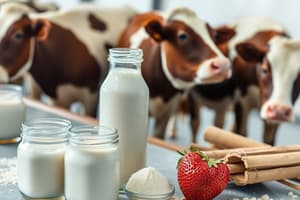Podcast
Questions and Answers
Which type of milk composition is used to differentiate the nutritional values across different animal milks?
Which type of milk composition is used to differentiate the nutritional values across different animal milks?
- Physical state analysis
- Comparative composition analysis (correct)
- Chemical farming designation
- Microbial contamination levels
What should be considered as minor constituents in milk?
What should be considered as minor constituents in milk?
- Proteins and fats
- Vitamins and minerals (correct)
- Carbohydrates and sugars
- Water and lactose
What is the main purpose of testing for adulterants in milk?
What is the main purpose of testing for adulterants in milk?
- To ensure safety and quality (correct)
- To increase shelf life
- To enhance flavor enhancement
- To decrease cost of production
Which property is NOT typically assessed for its influence on milk quality?
Which property is NOT typically assessed for its influence on milk quality?
What differentiates cow milk from buffalo milk in composition?
What differentiates cow milk from buffalo milk in composition?
Which of the following components is considered a major constituent of milk?
Which of the following components is considered a major constituent of milk?
What role do preservatives play in milk?
What role do preservatives play in milk?
What is analyzed to evaluate the physicochemical properties of milk?
What is analyzed to evaluate the physicochemical properties of milk?
Flashcards are hidden until you start studying
Study Notes
Dairy Chemistry: Composition and Constituents of Milk
-
Milk: A Complex Fluid: Milk is a complex liquid produced by mammals for nourishing their offspring. This course explores the composition, properties, and chemistry of milk, especially cow and buffalo milk.
-
Composition Variations: Milk composition varies based on species.
- Cow Milk: Contains approximately 87% water, 3.5% fat, 3.5% lactose, and 3.5% protein.
- Buffalo Milk: Differs significantly with a higher fat content (around 7%) and a lower lactose content (around 4%).
- Sheep, Goat, and Human Milk: These milks also have varying compositions. For example, Goat milk has a higher fat content and a lower lactose content compared to cow milk. Human milk is significantly different in its composition, tailored specifically for human infants.
Constituents of Milk: Major and Minor Components
-
Major Constituents:
- Water: The primary component of milk, forming about 87%.
- Fat: Typically around 3.5% in cow milk, but can vary based on breed, diet, and stage of lactation.
- Lactose: A milk sugar, contributing to milk's sweetness.
- Proteins: Milk contains a complex mixture of proteins, including casein, whey protein, and others.
-
Minor Constituents: These include minerals (calcium, phosphorus, potassium), vitamins (riboflavin, vitamin A), enzymes (lactase, lipase), and other substances that play critical roles in milk quality and functionality.
Studying That Suits You
Use AI to generate personalized quizzes and flashcards to suit your learning preferences.




